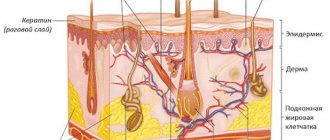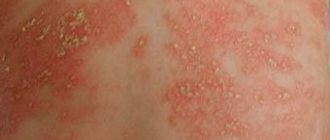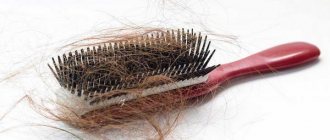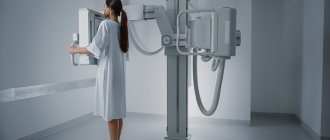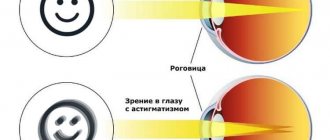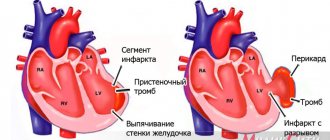Every cell of the human body has a connection with the nervous system - the ancient part of it, which we do not control, and the young cortex, which issues commands from consciousness. The message is carried out using nerve fibers, and they can exist normally if they are not under pressure from the outside and are not damaged from the inside. When such a situation does arise, it manifests itself as a sensation as if goosebumps are running down the skin. Then this symptom is not associated with the experience of any emotions and does not go away after switching to another thought.
Let us examine in more detail what this or that localization of these unpleasant sensations may mean, and what the duration of the “goosebumps” indicates.
Types and mechanism of “goosebumps”
The sensation of tingling and crawling is medically called “paresthesia.” They appear in response to irritation of nerve endings, the brain or spinal cord. The nature of this phenomenon is as follows: the sensitive nerve ending receives several different unrelated signals at once, layering on top of each other. As a result, the nerve does not know how to react correctly to this variety, and “turns on” numbness, burning, “pins and needles” or tingling.
Paresthesia is usually felt below the irritated area of the nerve. They may be accompanied by “goose bumps” - “pimples” in the area of hair growth, which is an analogue of the puffiness of fur or quills in animals.
Paresthesias can be:
- temporary, occurring when sitting in an uncomfortable position, freezing, sexual arousal, a feeling of euphoria from listening to music or when negative emotions appear. They are usually described as “pins and needles on your legs” and go away when the irritating factor stops. Not accompanied by cramps, pain or sensory disturbances;
- chronic, recurring. They are signs of the disease, and can be accompanied by two types of symptoms:
- indicating damage to the nerve fiber. These are: numbness in the limbs or only in the fingers, tingling sensation, goosebumps. Sometimes local twitching (convulsions) develops here;
- indicating damage to those nerves that are connected to the vessels of this area. This is evidenced by: pale skin, deterioration of temperature and pain sensitivity, cool temperature, hair loss.
Transient (temporary) paresthesia is a variant of the norm and does not require medical intervention. If “goosebumps” run without any visible effect on the skin, you definitely need to look for their cause and eliminate it.
4.Treatment
It is easy to see that with the number and variety of possible causes for the development of paresthesia described above, it is impossible to indicate universal therapeutic regimens (or at least general approaches to its treatment). Prescriptions, of course, take into account the entire array of diagnostic data obtained. In some cases, vitamin therapy may be sufficient, in others it is impossible to do without vertebrological or neurosurgical oncology intervention, in others, the only solution may be a change of job (if, for example, the profession is associated with chemical hazards). If paresthesia occurs against the background or as part of a chronic disease of the endocrine, cardiovascular or other system, it will be necessary, first of all, to treat and/or relieve the exacerbation of the underlying disease.
However, in any case, if any unusual, unusual, outwardly inexplicable sensations in the skin occur, you should definitely consult a doctor, since paresthesia sometimes turns out to be only a harbinger of much more serious problems or the tip of a formidable iceberg, which for the time being does not manifest itself in anything else.
What diseases provoke paresthesia?
The causes of goosebumps are varied. Let's list them first:
- osteochondrosis;
- damage to nerve fibers of various localizations - neuropathy;
- high blood glucose levels;
- impaired nutrition of nerve fibers due to diabetes mellitus, poisoning, including chronic alcohol intoxication - polyneuropathy;
- low blood levels of calcium or magnesium;
- nerve fiber injury;
- damage to nerve fibers by antibodies;
- varicose veins;
- migraine;
- Raynaud's syndrome;
- atherosclerosis of arterial vessels;
- insufficient intake of vitamins B1, 6, C;
- arthritis;
- restless legs syndrome;
- tumors of nerve fibers;
- tumor in the parietal lobe of the brain;
- autoimmune vascular damage - vasculitis;
- insufficiency of parathyroid gland function – hypoparathyroidism;
- neurasthenia;
- obliterating endarteritis;
- multiple sclerosis;
- trigeminal neuralgia;
- stroke;
- taking certain medications;
- shingles;
- rabies;
- follicular hyperkeratosis;
- entry of the filling mass into the canal of a tooth with a living nerve;
- damage to the nerve ending during tooth extraction.
If “goose bumps” is the name given to the external manifestation – “goose bumps”, without any other symptoms, then this pathology is called follicular hyperkeratosis.
Here, due to poor nutrition of the skin or constant irritation, the upper layer of the skin thickens excessively, and the mouths of the hair follicles become inflamed. Dermatocosmetologists treat pathology with various local and systemic means.
2. Reasons
The main causes of paresthesia include: - mechanical and/or hemodynamic factors directly acting on the nerve (pressure, irritation, trauma, impaired blood supply during prolonged immobility in a “clamped” position, vascular inflammation, varicose veins, etc.);
- autoimmune disorders affecting nerve pathways;
- processes of neurodegeneration and demyelination of nerve sheaths (including with polyneuropathies, in particular, alcoholic origin, with multiple sclerosis, etc.);
- metabolic disorders (including diabetes mellitus and other endocrine disorders);
- atherosclerosis;
- viral lesions of nerve pathways;
- oncopathology (in particular, tumors in the area of the spinal nerve processes, in the parietal parts of the cerebral cortex);
- deficiency of vitamins (especially group B);
- intoxication with certain substances (heavy metal compounds, organic solvents, etc.);
- diseases of the musculoskeletal system (arthritis, intervertebral hernia, osteochondrosis with “radicular syndrome”, etc.).
This list includes, we emphasize, only the most common causes of paresthesia; in fact, the list could go on for a long time. Thus, paresthesia occurs in some mental disorders, before or after an epileptic seizure, sometimes as a consequence of a stroke or as a local reaction to the bite of animals infected with rabies, in otolaryngological and cardiovascular diseases, certain types of dental surgery, etc.
Visit our Neurology page
Goosebumps on the body, arms and legs
This symptom is accompanied by many diseases. Let's consider the main ones in more detail.
Hypovitaminosis B1
Vitamin B1 is needed for the normal functioning of the nervous system. It is involved in the production of acetylcholine - a substance that allows a nerve impulse to reach the muscle, intestines, sweat gland, heart - and transmit its command to it. Its insufficient intake from food or acceleration of its breakdown leads to:
- feeling of pins and needles on the legs and arms;
- irritability;
- headache;
- memory impairment;
- constipation;
- increased heart rate;
- pain in the heart;
- swelling;
- shortness of breath;
- sometimes even paralysis and cardiovascular failure.
Such symptoms require prompt diagnosis and treatment: administration of synthetic vitamin thiamine and diet correction.
Hypoparathyroidism
This is a reduced function of the parathyroid glands, in which the level of calcium in the blood decreases. It manifests itself not only as goose bumps in the limbs, but also:
- painful contractions of the muscles of the limbs, body and face: the arm is brought towards the body, it is “bent” at the wrist and elbow joints, the corners of the mouth are lowered, the eyelids are lowered by half, the body is arched back;
- swallowing is paroxysmally impaired;
- there is a stabbing pain in the abdomen;
- there may be vomiting, diarrhea;
- fainting occurs;
- twilight vision is impaired;
- "pawns ears;
- there are pains and interruptions in the heart;
- hair becomes thinner, the number of hair shafts falling out increases;
- the skin is peeling;
- a large number of teeth are affected by caries;
- nails become dull;
- With prolonged absence of therapy, cataracts develop.
Decreased calcium levels
Here the same symptoms develop as with hypoparathyroidism, but they are not as pronounced and occur more easily. Often, the pathology is manifested only by painful spasms of the muscles of the limbs and face, which immediately follow goosebumps, increased heart rate, trembling and recurrent vomiting. With an extremely low level of this electrolyte in the blood, difficulty breathing may develop until it stops, and painful arching of the entire body.
Low blood magnesium levels
This condition manifests itself:
- weakness;
- lack of appetite;
- nausea, vomiting;
- trembling of the body or individual muscles;
- Convulsions may occur in which the entire body contracts or arches. This is most common in children.
Taking medications
The appearance of goose bumps can be caused by taking drugs such as: Ofloxacin, Protionamide, Isonazid, Cycloserine, drugs against epilepsy and blood pressure lowering drugs.
Arrhythmias
In the case of the development of attack-like (paroxysmal) rhythm disturbances, a person may notice:
- “goosebumps” running over the body;
- chills at normal body temperature.
This state lasts from ten minutes or more; most often develops at night.
Brain stroke
Paralysis or partial immobility of the limbs on one side may be preceded by a feeling of numbness and crawling, sometimes on the opposite side. There is also a headache, there may be short- or long-term loss of consciousness, focal symptoms are observed: facial asymmetry, different widths of the palpebral fissures, inability to speak or understand speech.
Damage to the parietal lobe of the brain
A tumor or encephalitis that develops in the lobe responsible for sensitivity is accompanied by other symptoms: the inability to perform complex actions, failure to recognize objects if you close your eyes and feel them with your hands, loss of the ability to write. There may also be loss of half of the visual field and loss of awareness of one's own body diagram.
Guillain-Barre syndrome
This condition occurs after a viral infection (mainly colds and herpes), or intestinal infection caused by the Campylobacter bacterium or enteroviruses.
Here, in the period from 5 to 21 days after the illness, antibodies are formed to certain areas of the spinal nerve roots. This is manifested by the appearance of pins and needles on the legs, the range of movements gradually decreases, and sensitivity is impaired. The process may appear immediately on your hands. It may involve a certain volume, but may spread towards the chest. The last symptom is very dangerous and requires urgent hospitalization in the intensive care unit, as it can progress to respiratory arrest.
Head injury
A brain contusion can lead to the appearance of pins and needles on both one and two sides. After this, loss of sensation may develop.
Shingles
The disease is caused by the same virus as chickenpox; occurs in those who have already had it. It manifests itself as the appearance of goosebumps in the projection of any nerve, but more often - one of the intercostal nerves. Goosebumps precede the appearance of redness here, on which bubbles with transparent contents soon appear. The affected area burns and hurts.
Multiple sclerosis
This is an autoimmune pathology when one’s own antibodies begin to attack the membrane of most nerve fibers, as a result of which the latter become “naked” and begin to destroy themselves. There is no clear sequence or algorithm for damage to fibers, so it is difficult to recognize the disease.
Most often, it begins with deterioration of vision in one eye, the sensation of a foreign body in it, and the appearance of blurred contours of the objects in question. This condition lasts about a week, then goes away on its own, but not completely. Subsequently, the symptom will recur. Gradually, it leads to disruption of coordinated eye movements and a change in the normal reaction of the pupils to light. Usually, after this, goosebumps and pain appear on the face, which is the basis for making a diagnosis of “Facial neuritis” or “Trigeminal neuralgia”. Later, loss of coordination, changes in handwriting, and transient trembling of objects develop.
Also, the initial manifestations of the disease include goosebumps, burning, numbness or tightening of the skin that occurs on any part of the body. It goes away on its own and often does not serve as a reason to contact a neurologist or therapist.
Polyneuropathy
This disease is characterized by damage to the peripheral nervous system due to poisoning (including alcohol surrogates), metabolic disorders (mainly due to diabetes mellitus). It is dangerous because the disconnection of nerves, starting from distant parts of the body (fingers and toes), spreads closer and closer to the respiratory muscles, and can also involve the nerves that command the contraction of the muscles responsible for breathing.
Polyneuropathy manifests itself as a deterioration in the motor activity of the legs and arms, starting with the fingers, the appearance of goosebumps and numbness in these areas, and the gradual “turning off” of sensitivity in the areas of socks and gloves.
GOOSEBUMPS. How the skin expresses emotions
Goosebumps, goosebumps, hair standing on end... There are so many names for this extraordinary reaction of our body! But we are always talking about one thing - the pilomotor reflex. It is this reflex that scientifically describes the raising of hairs above the surface of the skin. What are the reasons? It's not just about emotions.
Where do goosebumps come from?
Pilomotor reflex, also known as PMR
(or piloerection) is a contraction of the hair muscles under the influence of skin irritation or various psycho-emotional states.
Our skin is capable of becoming covered with small tubercles and raising hairs not only when we are cold. There is also a direct connection between the wave of goosebumps and emotions.
There is a scientific opinion that PMR exists exclusively in mammals, and even then, not in all. This reflex helps angry animals with fur to express their readiness to attack (furring of fur as a sign of impending danger). When the hairs rise, the figure of the attacker becomes larger and scarier than it really is.
Interesting:
A very striking example of PMR in wildlife can be observed in the porcupine, whose quills serve as a direct means of defense and attack. When the need arises to protect itself from other individuals, its needles literally stand on end, ready to “shoot” at any moment.
Goosebumps can't be controlled?
In humans, every hair on the body is located in the so-called hair follicle. And each hair bag is attached in a jewelry way to a small smooth muscle called arrector pili. When the muscle contracts, it pulls the hair upward, and it partially comes out of its hair follicle, forming a tubercle. This is how you get goosebumps!
Important:
a person cannot control the functioning of smooth muscles and the sympathetic nervous system, since they are part of the autonomic nervous system, which controls internal organs.
What do goose bumps affect?
The sympathetic division of the nervous system is responsible for arousal. It is activated as soon as we begin to be overwhelmed by emotions or overcome by fear. But goosebumps also appear from cold and pleasant or, conversely, unpleasant sensations. In this case, excitement will also have an emotional aspect, since cold causes fear and fear for life, and we either want to escape from certain sensations or for them to never end.
Small smooth muscles help keep the hair follicle alive. In the place where the muscles attach to the hair bulb, stem cells are formed. They are necessary for the renewal of the follicle itself and hair growth. As soon as goosebumps begin to run through the body, the nerves transmit an excitation signal to the muscles, and then an interesting thing happens to the stem cells - they turn into hair follicles and give rise to hair growth.
Thus, the more we experience goosebumps, the stronger the hair sits under the skin and the better its quality.
Important:
where hair does not grow, there is no “goose bumps” effect.
Severing the muscle from the hair follicle and replacing it with adipose tissue leads to the fact that the stem cells disappear, the hair falls out and the person goes bald. If there is no hair muscle, there will be no PMR: goosebumps no longer appear on bald areas. So experiencing strong emotions is good for your hair. If you get goosebumps from beautiful music or empathy for the characters in a movie or book, then congratulations - blood flow and muscle stimulation have a great effect on health and beauty.
Goosebumps on the face and hands
If goosebumps crawl on the skin of your face and hands, this may be one of the following pathologies.
Migraine
At first, goosebumps appear on the face (especially around the mouth) and hands, then a headache develops mainly in one half of the head. In this case, paresthesia should be regarded as a migraine aura - a condition that precedes an attack of pain.
Tumor or inflammation of the frontal lobe of the brain
A change in personality (a person becomes “not the same as usual”) along with goosebumps in the lips and fingers may indicate damage to the frontal lobe. Only a neurologist can refute such a diagnosis, sometimes only on the basis of an MRI of the brain.
Early menopause in women: treatment options
In their youth, representatives of the fair sex are rarely satisfied with their reflection in the mirror. For some women, the feeling that “the reflection needs replacing” persists throughout their lives. But most of us, looking at old photographs, still smile: “Wow, I never liked myself in this picture!” But how pretty I was then.
We take care of our skin, some more, some less, we run to a cosmetologist, make masks, buy expensive creams. We are very afraid of losing our youth and beauty. We are afraid of approaching old age, wrinkles, bags under the eyes, dry and flabby skin, and a toothless mouth. The most common question among women with cycle disorders aged “35+”:
— Doctor, my period is delayed by 10 days and I feel somehow wrong. Is this already menopause?
Let's define the terms
Menopause
- the time of the last menstruation in a woman’s life. The onset is usually determined retrospectively, after there has been no menstruation for 12 months.
The average age of menopause in our country is approximately 50 years (46–54 years). Based on this, two more important terms appear: early menopause
- under the age of 45;
premature menopause
- before the age of 40;
period of menopausal transition
- begins at 40–45 years and ends with the onset of menopause. This is a period when menstruation can be “confused,” hormones can “jump,” and women slowly begin to develop a motley picture of symptoms of estrogen deficiency.
Very rarely, in about 1% of women in the population, an even sadder story occurs - ovarian wasting syndrome
, or premature ovarian failure. Young women under 36 years of age, who had regular menstruation and even realized their reproductive function, suddenly note the cessation of menstruation in combination with all the “joys” of estrogen deficiency: hot flashes, night sweats, palpitations, sleep disturbances, psycho-emotional lability, dizziness and headaches, weakness, tingling in fingers, hair loss.
Diagnosis of the condition
The diagnosis is not particularly difficult. Early/premature menopause and ovarian wasting syndrome are characterized by the absence of menstruation, symptoms of estrogen deficiency, FSH levels consistently above 25 IU/l, estrogen levels less than 30 pmol/l and ultrasound findings (reduced ovarian size, absence of the follicular apparatus). For reliability, hormonal testing can be repeated twice with an interval of 4–6 weeks.
Goosebumps on the scalp
If you have goosebumps on the back of your head, it could be:
- Neuropathy of the greater occipital nerve. At the same time, goosebumps, numbness and tingling are felt in the area of the back of the head to the crown; here there is increased or decreased sensitivity. You can find pain points in the back of the head.
- Neuropathy of the cervical plexus with compression of its sensory nerves. Here in the area of the back of the head, neck, shoulder girdle and behind the ear, pain and goosebumps are felt.
- Transient ischemic attack (ministroke). In this case, the tingling sensation is felt for 1-2 hours, then disappears, leaving no focal changes.
- Bell's palsy. At first, goosebumps are felt on one side of the face, after which weakness of the muscles on this side appears, and then they completely cease to provide movement to one side of the mouth and facial muscles.
Goosebumps on your hands
If you notice goosebumps crawling on your arm, please note: this may be due to the following reasons.
Anterior scalene syndrome
When this muscle is overstrained, which is caused by compression of the lower trunk of the brachial plexus and the subclavian artery, pain and pins and needles are noted in the arm - from the shoulder to the little finger and ring finger. When turning the head, the pain radiates to the back of the head and chest. There may be numbness and chilliness in the hand, and the skin becomes pale or more bluish.
Brachial plexus syndrome
It is characterized by deterioration of movement in the hand, goosebumps and decreased sensitivity in the part of the hand that is located on the little finger side.
Raynaud's disease
Manifested by coldness and paleness of the fingers. Goosebumps crawl over them, the fingers first turn blue and begin to hurt, then their skin turns red, and the pain subsides. Often not only the fingers, but also the toes are affected.
Osteochondrosis, trauma, spondylolisthesis or tumor of the cervical spinal cord
These diseases are characterized not only by the appearance of goose bumps in the hands, but also by pain in the muscles of the hands, a gradual decrease in strength in their muscles, and a deterioration in temperature and pain sensitivity in the hands. If a pathological process (tumor, edema or vertebrae) compresses the vessels leading to the brain, dizziness, hearing or vision impairment will occur.
Myositis of the cervical muscles
Goosebumps in the arms are accompanied by pain in the neck. These symptoms are worse in certain positions of the neck. Read more about myositis.
Costoclavicular syndrome
This is the name for compression of the vessels and nerves of the brachial plexus, which occurs in a vertical position if the shoulder girdle is pulled back and down (for example, when carrying a heavy backpack). In this case, pain when standing at attention, accompanied by goosebumps, develops along the inside of the hand and forearm.
Musculocutaneous nerve neuropathy
This nerve gives commands to many muscles of the shoulder, including the biceps, reaching the forearm, it is divided into anterior and posterior branches. If the nerve is pinched at the level of the elbow fold, pain occurs in this place, which radiates to the side of the forearm and is accompanied by a burning sensation and goosebumps. The pain intensifies with flexion and extension of the elbow, and rotation of the forearm in and out.
Compression of the median nerve in the axillary fossa
The pathology occurs mainly when carrying heavy objects resting on the armpit, as well as when spouses sleep together, when the head of one of them is under the arm of the other.
Here goosebumps run across the palm; at first this is not accompanied by pain or dysfunction. If a similar situation with compression is repeated, the work of the flexor muscles of the palm and those muscles that are responsible for flexing the thumb and index fingers worsens. The palm loses its sensitivity; the muscles that form the eminence of the thumb are hypotrophied.
Intermetacarpal tunnel syndrome
This is the name of the condition when the nerve is pinched by the heads of the metacarpal bones. Symptoms: numbness and pins and needles in the area of the surfaces of the fingers facing each other, which intensify with flexion and extension of the fingers.
Pinched nerve between the heads of the triceps muscle
The causes of the condition are injury to the back of the arm, fracture of the humerus.
Symptoms: deterioration or inability to straighten the hand; if you press on the back of the forearm, pain and pins and needles appear near the thumb.
Compression of the dorsal branch of the ulnar nerve
This occurs due to the habit of resting your elbow on the edge of the table. Pain occurs on the inside of the hand. If you press on the inside of the wrist, the pain intensifies and a pins and needles sensation appears.
Fight or flight response
In humans, adrenaline is often released not only when we are cold or scared, but also when we are in a stressful situation and experience strong emotions, such as anger or excitement. Other signs of an adrenaline rush include tears, sweaty palms, trembling hands, increased blood pressure, increased heart rate, or a feeling of butterflies in the stomach. Similar symptoms also occur in the basic fight-or-flight mode. Do you often get goosebumps and why? You can discuss this and other strange functions of our body in our Telegram chat, subscribe!
Goose bumps are the same rudiment as the tailbone and wisdom teeth
From each hair follicle, about 20 hairs grow sequentially throughout life.
In fact, for our brains, anything highly emotional—both good and bad—can be classified as a threat, at least at first glance. So a loud noise, a squeal or a high note from your favorite singer sounds almost the same to our brain - it's a scream, and it means danger. This happens thanks to the amygdala, an area of the brain that plays an important role in processing emotions. Adrenaline is triggered by loud noises or high-pitched screams (such as a sustained high note on a violin) that are interpreted as truly threatening. Considering that we have long lost excess body hair, will we eventually lose goosebumps too? According to Discover Magazine, goosebumps, according to researchers, are essentially a byproduct of the functional fight-or-flight response that has always been inherent to our species' survival.
Goosebumps on my feet
The symptom of goosebumps “running” down the leg is caused by various conditions. Let's look at the main ones.
Lumbar plexus neuropathy
It appears due to compression of the plexus by altered upper lumbar vertebrae, hematomas, abscesses, phlegmons, and tumors in this area.
Symptoms: pain and pins and needles - in the lower abdomen, in the pelvic area, on the thigh. They intensify when the extended leg is raised upward.
Varicose veins
The legs, especially when standing for a long time and at the end of the working day, itch, swell, and feel heaviness. Dilated veins and purple vascular networks are visually identified.
Restless legs syndrome
This is the name of a condition caused by various reasons, when a burning, tingling, feeling of bursting or squeezing is felt in the legs, due to which the lower limbs perform a frequent reflex movement of “throwing off”.
To clarify and eliminate the cause of such sensations, contact a therapist and neurologist.
Bernhardt-Roth disease
It manifests itself:
- goosebumps, burning, numbness, tingling in the area from the hip joint along the anterolateral surface of the thigh to the knee;
- pain and pins and needles intensify when walking, disappear if you sit or lie with your legs bent;
- if you touch the skin in this area, it will hurt, you will feel a feeling of heat, a prick;
- sensitivity here is increased;
- There may be both dry skin and increased sweating in this area.
After lumbar puncture
Injury to the nerve roots during lumbar puncture can lead to pain, loss of sensation in the legs, and weakness in their muscles.
Operations on the spinal cord, spinal nerves, spine
If the nerve roots were injured during the intervention, the following occurs:
- goosebumps in the legs;
- weakness of the leg muscles;
- decreased sensitivity in the legs.
Raynaud's disease
It manifests itself as pain and coldness of the fingers, then the fingers turn blue, which is accompanied by increased pain. Then the vascular spasm goes away, the fingers turn red, and the pain and goosebumps go away.
Femoral nerve neuropathy
It can be caused by a fracture of the pelvic bones with bleeding into the muscles surrounding this nerve. It may occur if the nerve was injured during puncture of the femoral artery, or if it was compressed by lymph nodes or a hematoma localized in the area of the inguinal fold.
Symptoms:
- pain – in the groin area;
- spreads to the lumbar region, to the thigh and lower leg along their anterior internal surface;
- Here goosebumps are detected and sensitivity is reduced;
- flexion-extension of the hip and knee may be performed in too small a volume;
- climbing stairs is especially difficult.
Clamping of the saphenous nerve
Pins and needles, pain and loss of sensitivity are determined along the inside of the leg from the knee to the big toe.
Rabies
The disease occurs as a result of the bite of an infected animal, which introduces the rabies virus into the wound. Pathology manifests itself as the appearance of goosebumps in the bitten leg. Subsequently, fear of light, water and sound develops.
Treatment
Help before diagnosis
To prevent episodes of tingling feet, you need to choose shoes that fit well and are comfortable. For comfortable wearing of high-heeled shoes and boots, women are recommended to buy special insoles. To reduce discomfort after a long day on your feet, take a warm bath (possibly with essential oils) and lightly massage your feet and calves.
To improve blood circulation and innervation of the lower extremities, regular walking at a slow pace is suitable. Be sure to choose comfortable sneakers or boots, do not overexert yourself or try to walk at too fast a pace. To eliminate the tingling sensation inherent in restless legs syndrome, patients are advised to give up alcohol and caffeine, take walks before bed, and develop their own sleep ritual.
Conservative therapy
Treatment of tingling that occurs against the background of obliterating diseases of the lower extremities includes antiplatelet agents, anticoagulants and antispasmodics. The drugs improve blood supply to the distal parts of the legs, relieve discomfort and pain, and reduce the tingling sensation associated with walking. Targeted delivery of drugs by subcutaneous or intravenous injections is practiced.
Treatment for restless legs syndrome or polyneuropathy includes psychotropic medications. To relieve painful symptoms, herbal sedatives, benzodiazepine anticonvulsants, antidepressants and antipsychotics are prescribed. If tingling interferes with sleep, modern sleeping pills are indicated. A course of B vitamins helps improve neuromuscular transmission.
To eliminate paresthesia, physiotherapeutic techniques are widely used. When drugs are administered locally using electrophoresis or phonophoresis, pain and tingling disappear faster. Exposure to UHF or magnetic waves improves blood supply and has a trophic and anti-inflammatory effect. For vascular disorders, hyperbaric oxygenation, balneological procedures, and ozone therapy are used.
Goosebumps on the tongue
This is typical for:
- rubbing with dentures;
- changes in bite resulting from the removal of one or several teeth;
- galvanization, when an electric current occurs due to the fact that the crowns are made of different metals;
- getting filling material into the canal;
- hypovitaminosis B12;
- damage to the sensory fiber of the glossopharyngeal nerve;
- inflammation of the arachnoid membrane of the brain;
- peptic ulcer of the upper digestive system;
- diseases of the ENT organs: sinusitis, rhinitis.
Goosebumps in the back area
Goosebumps “run” down the back when there is a pathology of the spine, such as spondylosis. If the vertebrae in the cervical region are deformed, then goosebumps and pain will be felt in the neck, crown and upper back; they intensify with certain movements. If similar symptoms develop in the thoracic region, we are most likely talking about spondylosis or osteochondrosis of the thoracic region. Finally, in pathologies when the nerves coming from the lumbosacral region are pinched, goosebumps will be felt in the lumbar region.
Diagnostics
A patient who complains of tingling in the legs is examined by several specialists: a therapist, a neurologist, and a vascular surgeon. During a physical examination, attention is paid to the preservation or absence of pulsation in the arteries of the legs, signs of venous stagnation, and trophic disorders. Pathognomonic symptoms (Lasega, Dezherina, Bekhterev) help to establish neurological problems. To make a clinical diagnosis, the following are used:
- Vascular ultrasound.
Duplex scanning of the arterial and venous network of the lower extremities is an informative and safe method that shows the degree of preservation of blood flow, the width of blood vessels, and the presence of collateral circulation. The method reliably detects atherosclerotic plaques, blood clots, and pathological vascular spasms that cause tingling in the legs. - CT angiography.
Examination of the leg arteries with a contrast agent is considered the most accurate method for detecting signs of atherosclerosis and thrombus formation. The method is also recommended for suspected diabetic angiopathy, vasculitis, arteriovenous shunts. The results of CT angiography are needed to prepare for endovascular interventions. - ENMG.
Electroneuromyography data are indicative in the diagnosis of peripheral polyneuropathies. The study evaluates the speed of response of nerves to stimulation, based on the results of which the characteristics of neuromuscular impulse transmission are judged. The method shows the localization of the lesion and the extent of the pathological process. - X-ray of the spine.
An x-ray in 2 projections is performed to identify signs of osteochondrosis, vertebral subluxation, curvature or abnormal development of the spinal column, leading to tingling in the legs. To clarify the diagnosis, an MRI of the lumbosacral spine is performed. - Blood tests.
A glucose test is needed to exclude diabetic neuro- and angiopathy; the level of cytolysis enzymes is measured for possible hepatic neuropathy. To diagnose thromboangiitis, the results of a coagulogram and analysis of acute phase parameters are required.
Ultrasound of blood vessels of the lower extremities
Algorithm for analyzing the state when “goosebumps” appear
Before you panic, remember what caused the paresthesia. It is also important to assess your condition as objectively as possible and notice additional symptoms:
| Then the goosebumps appeared | Where are they felt? | Additional symptoms | What could it be | Which doctor should I contact? How to confirm? |
| After a spinal injury | In the limb area | Numbness, impaired sensitivity and movement in the limbs. With a cervical injury, there may be dizziness and loss of coordination. No goosebumps | Fracture, fracture-dislocation of vertebrae | Neuropathologist X-ray or computed tomography of the spine in the injured area |
| For no reason, but more often - if a person suffers from thrombosis, arrhythmias, hypertension | In the area of one half of the body | Sudden onset of poor sensitivity and inability to move the arm and leg on one side | Stroke | Neuropathologist Examination by an ambulance doctor, a neurologist, computed tomography of the brain performed under the supervision of a resuscitator |
| For no apparent reason | In the area of the limbs, but not on one side of the arm or leg, but grabbing either the foot (hand), or the foot and lower leg (hand and forearm), or the entire limb | Numbness, pallor of the skin, decreased local temperature, hair loss or decreased growth in the area where the “pins and needles” sensation is felt | Poor arterial patency: obliterating atherosclerosis or obliterating endarteritis. There may also be nerve compression | Vascular surgeon, neurologist Ultrasound with Dopplerography of the arteries of the extremities (both). Examination by a neurologist, checking tendon reflexes, electroneurography |
| With frequent alcohol consumption | In the area of the extremities (lower, upper or all) | The same | Alcoholic polyneuropathy | Examination by a neurologist, checking tendon reflexes |
| After an arm/leg injury | In the area of injury, above and below the point of impact | Feeling of “pins and needles”, decreased or increased sensitivity to cold/heat, muscle weakness of only this limb | Nerve fiber injury | Examination by a neurologist |
| After working with paints or heavy metals | Legs, arms | “Goosebumps” on the extremities (usually the legs), while sensitivity in the toe area decreases, and the muscles there become weak. Weakness and decreased sensation may also be observed in the hands, in the glove area, and spread along the arms/legs towards the torso | Toxic polyneuropathy | Examination by a neurologist, determination of sensitivity and tendon reflexes |
| If you have diabetes | In the area of both or four limbs | “Goosebumps” on the legs/arms, decreased sensitivity, muscle weakness | Diabetic polyneuropathy | Endocrinologist together with a neurologist Blood test for sugar (glucose) level, glycated hemoglobin level, electromyo- and electroneurography |
| For no apparent reason | In the area of the lower/upper or all 4 limbs | Changes in temperature and pain sensitivity, cold skin, muscle weakness | Vitamin deficiency (most likely B1) | Therapist – for adults, pediatrician – for children Examination by a neurologist, determination of the level of vitamins in the blood |
| During pregnancy | In the leg area | There are signs of pregnancy. There may be night cramps | Lack of magnesium or calcium | Therapist Determination of calcium and magnesium in blood |
| For no apparent reason | Both on the body and on the limbs | A persistent low fever that does not decrease with antibiotic treatment, but goes away on its own. Often - spots on the skin, there may be a “mesh pattern”. Losing weight. Pain in muscles, joints | Vasculitis | Therapist, rheumatologist Rheumatology tests, LE cells and other tests prescribed by a rheumatologist |
| Against the background of the same type of work | In a separate area of the limb (less commonly, the body) | Pain in this area, loss of sensitivity, “pins and needles”. Pass through time | Pinching or inflammation of a single nerve fiber | Neuropathologist Examination by a neurologist, determination of sensitivity and tendon reflexes |
| After a cold, intestinal infection, vaccination, surgery | It starts from the feet, can end there, and can rise, capturing the legs, thighs, hands, and forearms. Breathing, swallowing, and regulation of vascular tone may be impaired | Numbness, loss of sensitivity, muscle weakness, impaired movement of the limbs or their parts, up to paralysis, which can be treated if started in a timely manner. When immobilization of the limbs occurs, the “goosebumps” disappear | Infectious-allergic polyneuropathy (Guillain-Barré or Guillain-Barré-Landry syndrome) | Neuropathologist, sometimes together with infectious disease specialists Examination by a neurologist, determination of sensitivity and tendon reflexes |
| Either for no reason, or after suffering from acute respiratory viral infection | In any area, but more often - between the ribs | Chickenpox-type blisters are observed in the affected area. This is also accompanied by a burning sensation and pain when breathing | Herpes zoster | Infectious disease specialist together with a neurologist |
| For no apparent reason | Hands, face, mouth area | After goosebumps there is a headache, usually in one half of the head | Migraine with aura | Examination by a neurologist |
| After hypothermia | Separate area of the face | Pain in this area, lacrimation, increased sweating on this side | Trigeminal neuralgia | Examination by a neurologist |
| After an animal bite | At the site of the bite | Increased sensitivity of this area, sensation of a “twitching” muscle, photophobia, hydrophobia | Rabies | The diagnosis is made based on examination by an infectious disease specialist/radiologist |
| For no apparent reason | In any area | Accompanied by a completely different set of neurological symptoms: headache, loss of coordination, decreased vision, loss of sensitivity in any areas of the skin of the face, limbs, and torso | Multiple sclerosis, some mitochondrial diseases | MRI of the brain and cervical spinal cord with contrast, electroneurography, laboratory tests that will be prescribed by a neurologist after examination |
| For no apparent reason | “Goosebumps” appear in paroxysms on any part of the body, the location of which may vary. Most often they are felt in the back of the head | Distorted perception of one's own body parts, failure to recognize objects, inability to perform complex movements, loss of the ability to count and solve arithmetic problems. There may be loss of visual field | Damage (usually by tumor) to the parietal lobe of the brain | Neuropathologist MRI of the brain |
| After hypothermia of the head, overload of the neck muscles. Maybe for no apparent reason | In the back of the head | Severe pain in the back of the head, such as “drilling”, “shooting”, occurs in attacks. During the interictal period, a dull pain in the back of the head may remain. You can find points on the back of the head, pressure on which increases pain and goosebumps | Occipital neuralgia | Examination by a neurologist |
If you have goosebumps:
- run around the local area, especially in the limbs,
- this is not accompanied by disturbances of consciousness, vision, breathing, swallowing,
- does not rise to the respiratory tract,
it can be any of the neuropathies of numerous nerves. This diagnosis is made by a neurologist based on a routine examination of the patient. We will not list all the diagnoses in the table, especially since their treatment is the same.
The following important information regarding paresthesia should also be noted:
- the lower (closer to the toes) the area where the goose bumps are located, the closer to the tailbone the pathology is located;
- a large area of goosebumps running from a large (hip or shoulder) joint to the fingers indicates a pathology of the spine, while the reverse movement (from the fingers upward) indicates nerve damage;
- if sensitivity is impaired, pain appears and goosebumps appear in a small area between the hand (foot) and shoulder (thigh), most likely a small nerve fiber is damaged (compressed);
- pain that occurs along with goosebumps
- Goosebumps and sensory disturbances are especially dangerous in patients with diabetes, as well as after an intestinal or cold illness;
- anxiety and an urgent visit to a neurologist should be caused by conditions when, along with goosebumps, it is discovered that the affected area does not distinguish what kind of - sharp or blunt - object has touched it, and also does not distinguish between hot and cold water;
- You need to visit a neurologist or vascular surgeon if the skin where the goosebumps run has turned pale, cold, and has little pale hair growing on it.
Human Ancestors
Goosebumps are a physiological phenomenon inherited from our animal ancestors that was useful to them, but not very helpful to us. Essentially, goosebumps are tiny raised bumps on the skin that look like a bird's skin after its feathers have been plucked (we might as well call them "chicken skin" or "duck skin"). Goosebumps appear due to the contraction of miniature muscles that are attached to each hair. Each contracting muscle creates a shallow depression in the surface of the skin, which causes the surrounding area to bulge. But due to muscle contraction, the hair on our body stands on end whenever we are cold.
You may be interested in: Why do people need eyebrows?
This is because the thicker the hair layer on the body, the more heat is retained. Considering that the body of a modern person, although 95% is covered with hair, this is still not enough to retain heat, as happens with undercoat and wool. But why are the goosebumps preserved, but the dense hair layer is not? In fact, many animals have hair that stands on end not only because of the cold. Often this happens because the animals feel threatened - for example, when a cat is attacked by a dog, snake or other cat, its fur will immediately stand on end. Raised hair, as well as an arched back and the “side stance” that the animal often adopts, in the eyes of the enemy, make the cat larger and more aggressive. This should force the enemy to retreat. Read more about what organs we inherited from our ancestors in the material of my colleague Alexander Bogdanov.
The fight or flight response in action
It is noteworthy that you and I also get goose bumps in emotional situations, for example, when we are at a concert or football match, or when we watch a horror movie at home on TV. We also quite often get goosebumps many years after a significant event, just thinking about the emotions we once experienced. All of these reactions are caused by the subconscious release of a stress hormone called adrenaline. Adrenaline, which in humans is produced in the adrenal glands - paired glands located above the upper part of the kidneys in vertebrates, not only causes contraction of the skin muscles, but also affects many other reactions of the body. In animals, this hormone is released when it is cold or encounters a stressful situation. Adrenaline prepares the animal's body for the fight or flight response . But does goose bumps appear when our body is preparing for the same reaction?
You will find even more interesting facts about the human body on our Yandex.Zen channel. There are regularly published articles that are not on the site.
What can cause goosebumps in children
Goosebumps in children can be caused by:
- Guillain-Barre syndrome;
- intoxication (due to diphtheria or poisoning) polyneuropathy;
- encephalitis affecting the parietal region;
- scalene muscle syndrome due to an accessory rib;
- neuropathies due to muscle spasms;
- vasculitis;
- arthritis;
- taking certain medications;
- spondylosis;
- lack of B vitamins;
- hypocalcemia or hypomagnesemia.
Author:
Krivega Maria Salavatovna resuscitator
